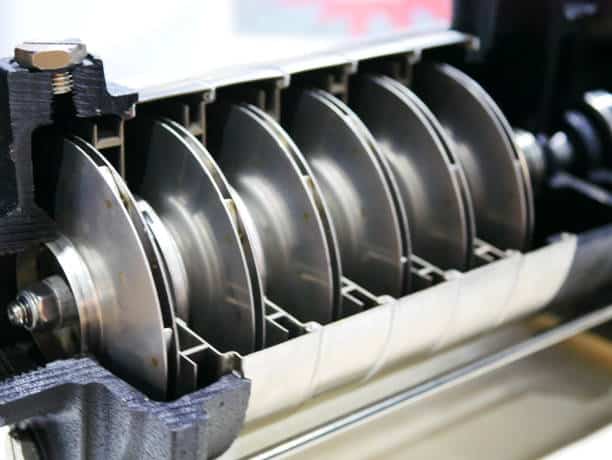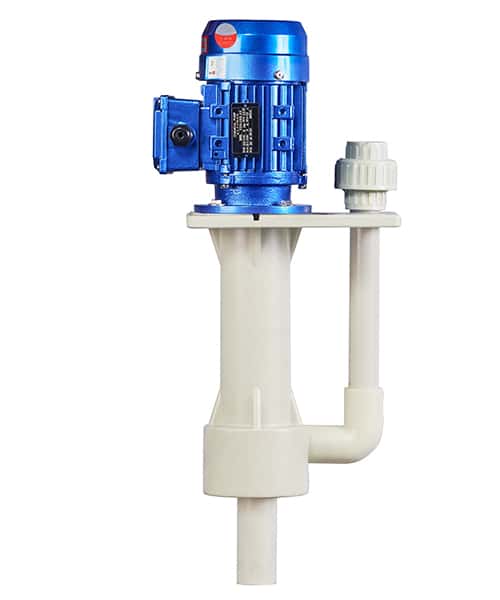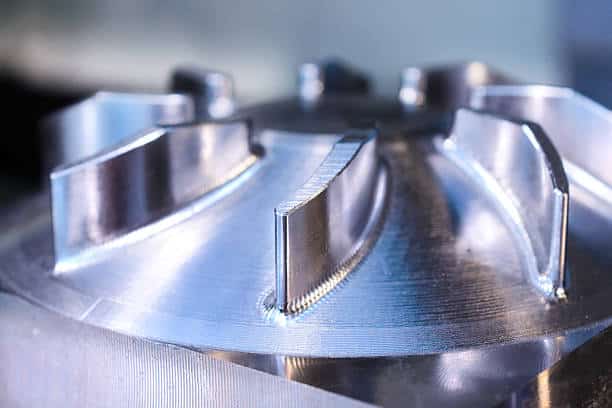Impeller
What is an impeller?
An impeller is a mechanical device, usually a rotating disk or cylindrical component with a series of blades or vanes that are designed to capture, propel, or manipulate a fluid (usually a liquid or gas) in a certain way. Impellers are widely used in a variety of mechanical and engineering applications, including turbines, pumps, fans, compressors, turbine engines, water turbines, and more.
Basic principles of impeller design
The basic principles of impeller design involve a number of key factors, including blade shape, number of blades, blade angle, and so on. These factors will vary from application to application, but the following are some general impeller design principles:
- Blade shape:
Blade shape is one of the key factors in impeller design. Blades are usually designed to have a streamlined shape to minimize drag and capture the kinetic energy of the fluid.
The cross sectional shape of the blades can be symmetrical or asymmetrical depending on the application requirements. Symmetrical blades are typically used to generate lift and asymmetrical blades are used to generate power.
The curves of the leading and trailing edges of the blades also affect the fluid flow and pressure distribution and therefore require special attention. - Number of blades:
The number of blades is one of the important parameters in impeller design. The number of blades affects the efficiency and performance of the impeller.
More blades usually capture the kinetic energy of the fluid better, but may result in higher drag and friction losses. Fewer blades may reduce drag, but may be less efficient.
The choice of the number of blades depends on the requirements of the particular application and needs to be weighed. - Blade angle:
The blade angle (or blade twist angle) is critical in impeller design. The blade angle determines the direction and velocity of the fluid entering and leaving the impeller.
The inlet angle of the blade determines the entry angle of the fluid, which affects the performance and efficiency of the impeller. Typically, the inlet angle of the blades needs to be optimized to capture the maximum amount of kinetic energy of the fluid.
The exit angle of the blade determines the direction of fluid departure, which also needs to be optimized to ensure that the fluid leaves the impeller with high efficiency. - Blade curvature and thickness:
The curve shape and thickness distribution of the blades are also design considerations. Proper curvature and thickness can improve the aerodynamic performance of the blade.
Curved blades can reduce centrifugal force and increase kinetic energy capture, but excessive curvature can lead to instability.
Thickness distribution usually needs to be optimized between the root and edge of the blade to balance strength and weight.

Influence of impeller diameter in centrifugal pumps
| Parameter | Trend with Increased Impeller Diameter | Approximate Relationship |
|---|---|---|
| Flow Rate (Q) | Increases linearly | $Q \propto D$ |
| Head (H) | Increases quadratically | $H \propto D^2$ |
| Power (P) | Increases cubically (most sensitive change) | $P \propto D^3$ |
Key Engineering Implications
- Larger impeller diameter → Increases flow and head, but may overload the motor if not checked.
- Impeller trimming (reduction) → Decreases flow and head, commonly used for system optimization and energy savings.
- After changing diameter, always recheck power requirement, efficiency, and NPSHr (Net Positive Suction Head Required).
- Efficiency may vary — bigger is not always better. Must match system and pump curve.
Usage Recommendations
- For small diameter changes (±10%), affinity laws provide reasonably accurate estimations.
- For large adjustments, consult the manufacturer’s reduced-diameter performance curves or conduct field testing.
- Before modifying, always verify: Pump casing clearance, motor capacity, and system resistance compatibility.
The role of impellers in different applications
The basic principles of impeller design involve a number of key factors, including blade shape, number of blades, blade angle, and so on. These factors will vary from application to application, but the following are some general impeller design principles:
Turbine impellers
Turbine impellers are a key power converter typically used in internal combustion and jet engines.
They rotate their blades to capture the kinetic energy of a gas (usually air) traveling at high speeds and convert it into mechanical power.
In internal combustion engines, turbine impellers are used to pressurize the engine and increase its performance and efficiency.
In jet engines, turbine impellers are used to propel a mixture of air and fuel, creating thrust to propel an airplane or other vehicle.
Pump impellers
Pump impellers are commonly used inside pumps, oil pumps and other liquid pumps.
They create negative pressure by rotating to draw liquid into the pump and push the liquid through a discharge port to a target location.
The design of pump impellers can affect the flow rate and pressure of the liquid for different liquid transfer needs(vertical chemical pump).


Widely used for liquid transfer and water supply in industry, construction and agriculture.
Fan impellers
Fan impellers are commonly used in ventilation systems, air conditioning systems and fan equipment.
They circulate air and regulate temperature by drawing air in and discharging it into the surrounding environment through a rotating motion.
The design of the fan impeller affects the flow and velocity of air, which can be adjusted as needed.
Used in homes, commercial buildings, and automobiles to maintain the temperature and ventilation of the room or equipment.
Hydraulic turbine impellers
Hydraulic turbine impellers are used in hydroelectric power plants to convert flowing water energy into mechanical power.
By rotating their blades, turbine impellers push a generator connected to them to produce electricity.
They play a key role in the renewable energy sector and are used to utilize water energy to generate electricity.
Compressor impellers
Compressor impellers are commonly used in compressors and air compressors to increase the pressure of gases.
They draw in and compress gases through a rotational motion, increasing their pressure for use in various applications such as cold storage, industrial processes, and refrigeration.

Impeller flow direction
The flow direction of an impeller depends on its design and intended application. There are two primary types of impellers—centrifugal and axial—each with distinct flow characteristics.
🔹 Centrifugal Impeller
In a centrifugal impeller, the fluid flows radially outward, from the center (inlet) toward the outer edge of the impeller.
As the impeller rotates, it imparts kinetic energy to the fluid, increasing its velocity and pressure as it exits the impeller.
This design is widely used in pumps, fans, blowers, and centrifugal compressors, where high-pressure fluid delivery is required.
🔹 Axial Impeller
An axial impeller directs the fluid parallel to the impeller shaft, moving it in the direction of the axis.
The blades of the impeller push the fluid forward in a straight-line flow, rather than outward from the center.
This type is commonly found in marine propellers, wind turbines, and industrial mixers, where high flow rates and low pressure differentials are needed.
Impeller material
- Metals:
Stainless steel: suitable for many applications with good corrosion resistance and mechanical strength.
Cast Iron: Commonly used in pump impellers for many water treatment applications.
Aluminum alloy: lightweight, commonly used in fans and light duty applications.
Nickel alloys: used in high-temperature, highly corrosive environments, such as impellers in aero-engines.
- Plastic materials:
Polypropylene: good corrosion tolerance
Polyethylene: used in some less corrosive applications.
Polytetrafluoroethylene (PTFE): used in highly corrosive and high temperature environments, such as in chemical processing equipment.
- Composites:
Glass fiber reinforced plastics (GRP): commonly used in some pump and fan impellers, combining strength and light weight.
Carbon fiber reinforced plastics (CFRP): lightweight but with high strength for high-performance applications.
- Ceramic materials:
Alumina ceramic: Used in high wear and high temperature environments, such as abrasive pump impellers.
Silicon carbide ceramics: good resistance to high temperatures and highly corrosive environments.
- Other materials:
Rubber and elastomers: used for vibration damping or handling corrosive fluids in some specialized applications.
Wood: Still used in some historic or specialty applications.

Impellers in centrifugal pumps
The impeller in a centrifugal pump is usually a disk-like structure with curved blades. Below are some common features and operating principles of centrifugal pump impellers:
- Vane shape: The impeller vanes of centrifugal pumps are usually in curved shapes, and these curved shapes are called curved vanes. This curved shape helps to increase the speed and pressure of the fluid, thus increasing the efficiency of the pump.
- Number of vanes: the impeller of centrifugal pump can have different number of vanes, usually more than one vane, but the number can be changed according to the design and performance requirements of the pump.
- Vane arrangement: the impeller vanes are usually arranged in the center of the centrifugal pump to form a disk. When the impeller rotates, the fluid is forced to move towards the outer edge of the impeller.
- Centrifugal force: Centrifugal pumps work on the principle of centrifugal force generation. As the impeller rotates, it pulls the fluid to the center and then pushes the fluid towards the outer edge of the impeller through the curved shape of the vanes. This process creates a centrifugal force that causes the fluid to flow out at a high velocity.
- Flow outlet: The flow outlet of a centrifugal pump is usually located at the outer edge of the impeller, where the fluid is pumped out of the pump and conveyed to the desired location, such as a piping system.
- Fluid pressurization: The design of the impeller allows the fluid to increase its velocity and pressure as it flows through the impeller, which makes centrifugal pumps suitable for applications where the fluid is transported from a low-pressure area to a high-pressure area.
Usually malfunctions:
- Wear and corrosion: Prolonged operation or handling of corrosive fluids may result in wear or corrosion of the impeller surfaces, reducing impeller efficiency and performance.
- Clogging: The pump inlet between the impeller vanes or in front of the impeller may become clogged, resulting in reduced fluid flow and increased pump workload.
- Imbalance: An out-of-balance impeller may cause vibration and noise, which in turn can damage the pump’s bearings and seals.
- Cavitation: Under certain conditions, gases in the fluid may form cavitation or cavitation around the impeller, reducing pump efficiency and damaging the impeller surface.
- Buildup accumulation: In the case of handling liquids with particles or sediments, these solid particles may build up on the impeller, reducing its efficiency.
- Overloading or overheating: Pump operation subjected to overloading or overheating may result in damage to the impeller and pump components, usually due to improper operating conditions or excessive loads.
- Impeller deformation or damage: Impellers subjected to external impact, collision or high temperatures may result in deformation or damage to the impeller, affecting pump performance.
- Stall: In some cases, the pump may stall due to too low or too high a flow of liquid, causing the impeller to stall and render the pump ineffective.
Centrifugal pump(vertical multistage pump) impellers work on a very simple but effective principle, and they are used in a wide variety of applications, including mains water supply, sewage treatment, industrial processes, heating and cooling systems. The performance characteristics and suitability of different centrifugal pumps depend on the design of the impeller, the size and material of the pump, and the operating conditions.
Impeller Maintenance and Troubleshooting
Maintenance and troubleshooting of impellers is an important aspect of ensuring their long-term reliable operation and performance. Below are some basic principles and frequently asked questions about impeller maintenance and troubleshooting:
Preserve
- Regular inspection and cleaning: Inspect the impeller regularly to ensure that there is no buildup of foreign material on the blades, such as deposits or corrosive material. Cleaning the impeller will improve its efficiency and reduce friction losses.
- Lubrication: If the impeller is in an environment that requires lubrication, ensure that the lubrication system is functioning properly to minimize wear on the impeller bearings.
- Balance calibration: Impellers need to be balanced during operation; imbalance can lead to vibration and mechanical failure. Regular balance calibration is an important part of maintenance.
- Tighten bolts: Regularly inspect and tighten bolts and nuts on the impeller to prevent loosening.
- Monitor performance: Establish a monitoring system to track impeller performance parameters such as flow, speed, temperature and vibration. This can help you identify problems early.

Fault resolution
- Vibrations and noise: If the impeller exhibits unusual vibrations or noise, this may be a sign of a balance problem, damaged blades or bearing failure. This needs to be checked and resolved promptly.
- Loss of efficiency: If the performance of the impeller is significantly reduced, this may be due to blade damage, scale buildup, or clogged runners. Cleaning and repair is required.
- Leakage: If the impeller of a liquid pump or fan is leaking, this could be a sign of a damaged seal or a crack in the impeller itself. The seal will need to be replaced and the impeller repaired or replaced.
- Excessive temperatures: If the turbine impeller or compressor impeller temperatures are above normal, this could be caused by inadequate lubrication or bearing problems. The lubrication system needs to be inspected and maintained.
- Uneven flow: If the impeller does not have an even distribution of fluid flow, this may be caused by damaged or contaminated vanes. The vanes and runners need to be inspected and necessary cleaning and maintenance performed.
- Bearing problems: If there are problems with the impeller’s bearings, such as noise, wear or overheating, the bearings need to be replaced promptly to prevent further damage.
- When performing maintenance and troubleshooting, always follow safe operating procedures and consider the specific application and environmental conditions for which the impeller is used. For more complex problems, specialized technicians may be required to perform repair and maintenance work to ensure the safety and performance of the impeller.
Summary
Impeller is a rotating mechanical element, commonly used in pumps, fans, compressors and other equipment, its main role is to convert mechanical energy into fluid kinetic energy, propulsion or transmission of liquids or gases, the specific shape and arrangement varies according to the application, in order to achieve the control, pressurization, mixing or transmission of fluids.
AOBL specializes in a wide range of high performance pumps and fluid handling equipment including AODD pumps, EODD pumps, double diaphragm pumps, sanitary diaphragm pumps, filter press feed pumps, progressive cavity pumps, magnetic drive pumps, vertical centrifugal pumps, chemical pumps, and a wide variety of parts and accessories. No matter what your needs are, we can provide you with exceptional solutions. Contact us anytime and let us find the best answer to your fluid transfer challenges!

